Introduction
Overview
This chip contains three cores:
LP: low power processor, KM0, and the firmware of Wi-Fi works on it.
NP: Network processor, KM4, and the driver of Wi-Fi works on it.
AP: Application processor, CA32, and the FullMAC works on it. The FullMAC driver is an adaptive driver between cfg80211 in Linux kernel and INIC device in FreeRTOS.
Architecture
The FullMAC is new Wi-Fi driver based on the CFG80211 interface. So it supports wpa_supplicant, hostapd, iwconfig, and so on. The driver sends the command to IPC INIC device on KM4 with IPC message and receives the event from IPC INIC device. Therefore, the FullMAC driver will convert the command and structure from CFG80211 to the IPC INIC commands and data type, and the events from IPC INIC device also are converted the format of CFG80211 and reported to the Linux kernel.
There are two IPC messages in FullMAC driver. One is the API message, and another is the data message. The API message is used to send command or receive event to manage the Wi-Fi. The data message is used to send or receive the data frame of Wi-Fi. So the former is low speed and the latter is high speed.
Configuration
Configuration in Kernel
Run the following command in build directory of project to open the configuration of kernel.
bitbake virtual/kernel -c menuconfig
Enabling Ameba IPC
The Wi-Fi driver in Linux is based on Ameba IPC’s driver, so the IPC’s driver must be enabled for Wi-Fi driver. Of course, this option is enabled if you choose Fullmac for rtl8730e to yes.
Device Drivers --->
<*> Drivers for Realtek --->
[*] Ameba IPC
Enabling CFG80211
This configuration is base of Wi-Fi driver based on cfg80211, and they are enabled by default.
[*] Networking support --->
-*- Wireless --->
<*> cfg80211 - wireless configuration API
[*] enable powersave by default
[*] support CRDA
[*] cfg80211 wireless extensions compatibility
Enabling FullMAC Driver
This configuration is used to enable Wi-Fi driver in Linux kernel, and it is enabled by default.
Device Drivers --->
<*> Drivers for Realtek --->
<*> CFG80211 WiFi FULLMAC drivers --->
<*> Fullmac for rtl8730e
Function
There are only two ports in Wi-Fi driver, wlan0 and wlan1. The wlan0 must work in station mode only and the wlan1 must work in access point (AP) mode only.
Initialization
The prerequisite that all APIs are valid in Linux, is the initialization of Wi-Fi IOCTL and event.
Initialization of IOCTL
None.
Initialization of Event
None.
Wi-Fi Data Structures
Data Structures |
Introduction |
|---|---|
<_cus_ie> |
The structure is used to set Wi-Fi custom IE list, and type match The IE will be transmitted according to the type. |
<rtw_ssid_t> |
The structure is used to describe the SSID. |
<rtw_mac_t> |
The structure is used to describe the unique 6-byte MAC address. |
<rtw_network_info_t> |
The structure is used to describe the station mode setting about SSID, security type and password, etc., used when connecting to an AP. |
<rtw_scan_param_t> |
The structure is used to describe the scan parameters used for scan, including SSID, channel, user callback, etc. |
<rtw_scan_result_t> |
The structure is used to describe the scan result of the AP. |
<rtw_wifi_setting_t> |
The structure is used to store the Wi-Fi setting gotten from Wi-Fi driver. |
<rtw_mac_filter_list_t> |
The structure is used to describe the mac filter list. |
<rtw_softap_info_t> |
The structure is used to describe the setting about SSID, security type, password, and default channel, used to start AP mode |
<psk_info> |
The structure is used to describe the SSID, passphrase and PSK which are used to get or store PSK info in the driver. |
<rtw_sw_statistics_t> |
The structure is used to describe the software statistics of Wi-Fi transmit and receive packets |
<rtw_phy_statistics_t> |
The structure is used to describe the PHY statistic info, which includes RSSI, SNR, false alarm from PHY layer, TRX counts from MAC layer |
<raw_data_desc_t> |
The structure is used to describe the raw frame to send by the user, including buffer address and length of the raw frame, and initial transmission rate which this frame will use. |
<wifi_user_conf> |
The structure is used to describe some configuration of Wi-Fi driver which can be controlled by the user. |
Wi-Fi APIs
System APIs
API |
Introduction |
|---|---|
<wifi_on> |
Enable Wi-Fi. |
<wifi_off> |
Disable Wi-Fi. |
<wifi_is_running> |
Check if the specified WLAN interface is running |
<wifi_set_mode> |
Used for switching Wi-Fi mode |
wifi_on
Enable Wi-Fi: bring the wireless interface Up.
Parameter |
Type |
Introduction |
|---|---|---|
<mode> |
rtw_mode_t |
Decide to enable Wi-Fi in which mode. The optional modes are enumerated in |
wifi_off
Disable Wi-Fi.
Parameter: None.
wifi_is_running
Check if the specified interface is up.
Parameter |
Type |
Introduction |
|---|---|---|
<wlan_idx> |
Unsigned char |
The idx can be set as
|
wifi_set_mode
Parameter |
Type |
Introduction |
|---|---|---|
<mode> |
int |
Decide to switch WiFi to which mode, the optional modes are:
|
Scan APIs
API |
Introduction |
|---|---|
<wifi_scan_networks> |
Initiate a scan to search for 802.11 networks |
<wifi_get_scan_records> |
Used to get scan results when |
<wifi_scan_abort> |
Abort ongoing Wi-Fi scan |
wifi_scan_networks
Initiate a scan to search for 802.11 networks.
Parameter |
Type |
Introduction |
|---|---|---|
<scan_param> |
rtw_scan_param_t * |
Specifies the scan parameters, including scan type, specific SSID, specific channel list, channel scan time, and scan callback. There are two types of scan callback:
If registered, scan_user_callback will be executed when the scan is finished and report the total number of scanned APs, and the detailed scanned AP info can be got by calling wifi_get_scan_records. This callback is suitable for a normal asynchronous scan. If registered, scan_report_each_mode_user_callback is used when configuring RTW_SCAN_REPORT_EACH in options of rtw_scan_param, and it will be executed every time a AP is scanned, and the AP info will be directly reported by this callback. |
<block> |
Unsigned char |
Specifies the scan as synchronous or asynchronous.
|
Note
If this API is called, the scanned APs are stored in Wi-Fi driver dynamic allocated memory, for a synchronous scan or asynchronous scan which does not use
RTW_SCAN_REPORT_EACH, these memories will be freed whenwifi_get_scan_records()is called.When configuring
RTW_SCAN_REPORT_EACH,scan_report_each_mode_user_callback()will report NULL to indicate that the scan is done.Only one callback function can be chosen to register. Both
scan_user_callback()andscan_report_each_mode_user_callback()are not supported to be registered in one scan.The scan callback function will be executed in the context of the RTW thread.
When scanning specific channels, devices with strong signal strength on nearby channels may be detected.
wifi_get_scan_records
Get scan results.
Parameter |
Type |
Introduction |
|---|---|---|
<AP_num> |
unsigned int * |
The pointer to the number of scanned AP info which wants to get, and it will be finally set to the number of scanned AP info which can actually get |
<scan_buf> |
char * |
The pointer to the buf where scan result will be stored, the scanned AP info will be stored one by one in form of struct rtw_scan_result_t. |
Note
For an asynchronous scan configuring RTW_SCAN_REPORT_EACH, every time an AP is scanned, the AP info will be directly reported through scan_report_each_mode_user_callback() and freed after user callback is executed, thus there is no need to use this function to get the scan result.
wifi_scan_abort
Abort ongoing scan.
Parameter: None.
Note
This is an asynchronous function and will return immediately. Return value only indicates whether the scan abort command is successfully notified to the driver or not. When the scan is actually aborted, the user callback registered in
wifi_scan_networks()will be executed.If there is no Wi-Fi scan in progress, this function will just return
RTW_SUCCESSand user callback won’t be executed.
Connection APIs
API |
Introduction |
|---|---|
<wifi_connect> |
Join a Wi-Fi network with a specified SSID or BSSID. |
<wifi_disconnect> |
Disassociates from current Wi-Fi network. |
<wifi_is_connected_to_ap> |
Check if Wi-Fi has connected to AP before DHCP. |
<wifi_get_join_status> |
Get latest Wi-Fi join status. |
<wifi_get_disconn_reason_code> |
Get reason code of latest disassociation or de-authentication. |
wifi_connect
Join a Wi-Fi network with a specified SSID or BSSID. Scan for, associate, and authenticate with a Wi-Fi network. On successful return, the system is ready to send data packets.
Parameter |
Type |
Introduction |
|---|---|---|
<connect_param> |
rtw_network_info_t * |
Describe the connection setting about SSID or BSSID, security type, password, and scan channel |
<block> |
unsigned char |
Determine the connection is synchronous or asynchronous.
|
Note
Make sure the Wi-Fi is enabled before invoking this function (
wifi_on()).The parameter channel and pscan_option in connect_param can be used to perform fast survey on the specified channel during Wi-Fi connection.
When the channel is set to a specified channel and pscan_option is set to
PSCAN_FAST_SURVEY, during Wi-Fi connection, an active scan will be only performed on the specified channel, the active scan will retry at most 8 times with each round interval 25 ms.joinstatus_user_callback()in connect_param can be registered to get the real-time join status changes since this callback will be executed every time join status is changed.
wifi_disconnect
Disassociates from current Wi-Fi network.
Parameter: None.
wifi_is_connected_to_ap
Check if Wi-Fi has connected to AP before DHCP.
Parameter: None.
wifi_get_join_status
Get the latest Wi-Fi join status.
Parameter: None.
Note
Wi-Fi join status will be set during Wi-Fi connection and Wi-Fi disconnection.
wifi_get_disconn_reason_code
Present the reason code of the latest disassociation or de-authentication.
Parameter |
Type |
Introduction |
|---|---|---|
<reason_code> |
unsigned short |
The pointer of reason code. |
Channel APIs
API |
Introduction |
|---|---|
<wifi_set_channel> |
Set the listening channel on STA interface. |
<wifi_get_channel> |
Get the current channel on STA interface. |
wifi_set_channel
Set the listening channel on STA interface.
Parameter |
Type |
Introduction |
|---|---|---|
<channel> |
int |
The desired channel. |
Note
Do not need to call this function for STA mode Wi-Fi driver, since it will be determined by the channel from the received beacon.
wifi_get_channel
Get the current channel on STA interface.
Parameter |
Type |
Introduction |
|---|---|---|
<channel> |
int * |
A pointer to the variable where the channel value will be written. |
Power Save API
API |
Introduction |
|---|---|
<wifi_set_powersave_mode> |
Set Wi-Fi power save mode. |
wifi_set_powersave_mode
Set Wi-Fi power save mode, including IPS mode and LPS mode.
IPS is the abbreviation of Inactive Power Save mode. Wi-Fi automatically turns RF off if it is not associated with AP.
LPS is the abbreviation of Leisure Power Save mode. Wi-Fi automatically turns RF off during the association with AP if traffic is not busy, while it also automatically turns RF on to listen to the beacon of the associated AP.
Parameter |
Type |
Introduction |
|---|---|---|
<ips_mode> |
u8 |
The desired ips mode, which can be:
|
<lps_mode> |
u8 |
The desired LPS mode, which can be:
|
AP Mode APIs
API |
Introduction |
|---|---|
<wifi_start_ap> |
Trigger Wi-Fi driver to start an infrastructure Wi-Fi network. |
<wifi_get_associated_client_list> |
Get the associated clients with SoftAP. |
<wifi_del_station> |
Delete a STA |
wifi_start_ap
Trigger Wi-Fi driver to start an infrastructure Wi-Fi network.
Parameter |
Type |
Introduction |
|---|---|---|
<softAP_config> |
rtw_softap_info_t * |
The pointer of a structure that stores the softAP configuration. |
Note
Make sure the Wi-Fi is enabled before invoking this function (
wifi_on()).If an STA interface is active when this function is called, the softAP will start on the same channel as the STA. It will not use the channel provided.
wifi_get_associated_client_list
Get the associated clients with SoftAP.
Parameter |
Type |
Introduction |
|---|---|---|
<client_list_buffer> |
int * |
The location where the client list will be stored. |
<buffer_length> |
unsigned short |
The buffer length. |
wifi_del_station
Delete an STA in AP mode.
Parameter |
Type |
Introduction |
|---|---|---|
<wlan_idx> |
unsigned char |
The WLAN interface index which AP is working on. |
<hwaddr> |
unsigned char * |
The pointer to the MAC address of the STA. |
Raw frame Tx API
API |
Introduction |
|---|---|
<wifi_send_raw_frame> |
Send a raw frame. |
wifi_send_raw_frame
Parameter |
Type |
Introduction |
|---|---|---|
<raw_data_desc> |
raw_data_desc_t * |
The pointer of a descriptor about the raw frame, including the buffer address where the frame is stored, frame length, the initial Tx rate of this frame (the default initial Tx rate will be 1Mbps). |
Custom IE APIs
API |
Introduction |
|---|---|
<wifi_add_custom_ie> |
Setup custom IE list. |
<wifi_update_custom_ie> |
Update the item in Wi-Fi custom IE list. |
<wifi_del_custom_ie> |
Delete Wi-Fi custom IE list. |
Note
These three APIs are only effective on beacon, probe request, and probe response frames.
wifi_add_custom_ie
Setup custom IE list.
Parameter |
Type |
Introduction |
|---|---|---|
<cus_ie> |
void * |
Pointer to Wi-Fi CUSTOM IE list. |
<ie_num> |
int |
The number of Wi-Fi CUSTOM IE list. |
Note
This API cannot be executed twice before deleting the previous custom IE list.
wifi_update_custom_ie
Update the item in Wi-Fi custom IE list.
Parameter |
Type |
Introduction |
|---|---|---|
<cus_ie> |
void * |
Pointer to Wi-Fi CUSTOM IE list. |
<ie_index> |
int |
The number of Wi-Fi CUSTOM IE list. |
wifi_del_custom_ie
Delete Wi-Fi custom IE list.
Parameter: None.
Wi-Fi Setting APIs
API |
Introduction |
|---|---|
<wifi_get_mac_address> |
Retrieve the current Media Access Control (MAC) address (or Ethernet hardware address) of the 802.11 devices. |
<wifi_get_setting> |
Get current Wi-Fi settings from the driver. |
<wifi_set_network_mode> |
Set the network mode according to the data rate it supported. |
<wifi_set_mfp_support> |
Set Management Frame Protection Support Capability. |
<wifi_set_group_id> |
Set group ID of finite cyclic group for SAE transactions. |
<wifi_set_pmk_cache_enable> |
Enable or disable PMK cache. |
<wifi_psk_info_set> |
Set PSK-related info to the driver, including SSID, passphrase, PSK. |
<wifi_psk_info_get> |
Get PSK-related info from the driver, including SSID, passphrase, PSK. |
<wifi_get_ccmp_key> |
Get encryption CCMP key used by Wi-Fi (STA mode only). |
<wifi_get_sw_statistic> |
Get the Tx and Rx statistic information which is counted by software. |
<wifi_fetch_phy_statistic> |
Fetch statistic info about Wi-Fi, including RSSI, SNR, TRX counting from the MAC layer. |
<wifi_set_indicate_mgnt> |
Configure mode of HW indicating packets (management and data frames) and SW reporting packets to wifi_indication(). |
<wifi_get_antenna_info> |
Get antenna information. |
<wifi_get_auto_chl> |
Get an auto channel using NMH algorithm. |
<wifi_get_band_type> |
Get band type. |
<wifi_get_tsf_low> |
Get Wi-Fi TSF value from Wi-Fi register. |
wifi_get_mac_address
Retrieve the current Media Access Control (MAC) address (or Ethernet hardware address) of the 802.11 devices.
Parameter |
Type |
Introduction |
|---|---|---|
<mac> |
char * |
Point to the result of the MAC address that will be got. |
wifi_get_setting
Get current Wi-Fi settings from the driver.
Parameter |
Type |
Introduction |
|---|---|---|
<wlan_idx> |
unsigned char |
The WLAN interface name:
|
<pSetting> |
rtw_wifi_setting_t * |
Points to the rtw_wifi_setting_t structure to store the Wi-Fi setting gotten from driver. |
wifi_set_network_mode
Set the network mode according to the data rate it supported. The driver works in BGN mode in default after driver initialization. This function is used to change wireless network mode for station mode before connecting to AP.
Parameter |
Type |
Introduction |
|---|---|---|
<mode> |
rtw_network_mode_t |
Network mode to set:
|
wifi_set_mfp_support
Set Management Frame Protection Support.
Parameter |
Type |
Introduction |
|---|---|---|
<value> |
unsigned char |
The value could be:
|
wifi_get_group_id
Set group ID of finite cyclic group for SAE transactions.
Parameter |
Type |
Introduction |
|---|---|---|
<value> |
unsigned char |
Specify the group ID of finite cyclic group for SAE transactions. |
wifi_set_pmk_cache_enable
Enable or disable PMK cache.
Parameter |
Type |
Introduction |
|---|---|---|
<value> |
unsigned char |
|
wifi_psk_info_set
Set PSK (pre-shared key) related information to the driver, including SSID, passphrase, PSK.
Normally used for fast connection to restore the PSK information to the driver after connecting to AP successfully, for shrinking PSK calculation time when the chip is power on again and wants to connect to the same AP.
Parameter |
Type |
Introduction |
|---|---|---|
<psk_data> |
struct psk_info * |
The pointer to the structure that will restore PSK-related info. |
wifi_psk_info_get
Get PSK-related information from the driver, including SSID, passphrase, PSK.
Normally used for fast connection to get PSK information from the driver and then store this information to Flash.
Parameter |
Type |
Introduction |
|---|---|---|
<psk_data> |
struct psk_info * |
The pointer to the structure that will restore PSK-related info. |
wifi_get_ccmp_key
Get encryption CCMP key used by Wi-Fi (STA mode only).
Parameter |
Type |
Introduction |
|---|---|---|
<uncst_key> |
unsigned char * |
The location where the CCMP TK (temporary key) will be stored. |
<group_key> |
unsigned char * |
The location where the CCMP GTK (group key) will be stored. |
wifi_get_sw_statistic
Show the Tx and Rx statistic information which is counted by software (Wi-Fi driver, not PHY layer)
Parameter |
Type |
Introduction |
|---|---|---|
<idx> |
unsigned char |
Specify the WLAN interface index from which WLAN interface the statistic info will be got |
<sw_statistics> |
rtw_sw_statistics_t * |
The pointer to the structure where store the software statistic |
wifi_fetch_phy_statistic
Fetch statistic info from WLAN interface 0, including RSSI, SNR, TRX counting from the MAC layer.
Parameter |
Type |
Introduction |
|---|---|---|
<phy_statistic> |
rtw_phy_statistics_t * |
The pointer to the structure that stores the PHY statistic |
wifi_set_indicate_mgnt
Configure mode of HW indicating packets (management and data frames) and SW reporting packets to wifi_indication().
Parameter |
Type |
Introduction |
|---|---|---|
<enable> |
int |
Value of enable could be:
|
wifi_get_antenna_info
Get antenna information.
Parameter |
Type |
Introduction |
|---|---|---|
<antenna> |
unsigned char * |
Points to store the antenna value gotten from the driver.
|
wifi_get_auto_chl
Get an auto channel by NMH algorithm, the selected channel is in the return value.
Parameter |
Type |
Introduction |
|---|---|---|
<wlan_idx> |
unsigned char |
The WLAN interface index, could be:
|
<channel_set> |
unsigned char * |
The pointer to the channel set which auto channel will be selected from. |
<channel_num> |
unsigned char |
The number of channels in channel set |
wifi_get_band_type
Get Wi-Fi band type, the value of band_type will be stored in the return value, and it can be:
WL_BAND_2_4G: only 2.4G supportedWL_BAND_5G: only 5G supportedWL_BAND_2_4G_5G_BOTH: both 2.4G and 5G supported
Parameter: None.
wifi_get_tsf_low
Get TSF value from Wi-Fi register.
Parameter |
Type |
Introduction |
|---|---|---|
<port> |
u32 |
Specify the Wi-Fi port which could be 0 or 1.
|
Wi-Fi Indication APIs
API |
Introduction |
|---|---|
<init_event_callback_list> |
Initialize the event callback list. |
<wifi_reg_event_handler> |
Register the event listener. |
<wifi_unreg_event_handler> |
Un-register the event listener. |
init_event_callback_list
Initialize the event callback list.
Parameter: None.
Note
Make sure this function has been invoked before using the event handler-related mechanism.
wifi_reg_event_handler
Register the event listener.
Parameter |
Type |
Introduction |
|---|---|---|
<event_cmds> |
unsigned int |
The event command number indicated. |
<handler_func> |
rtw_event_handler_t |
The callback function that will receive and process the event. |
<handler_user_data> |
void * |
User-specific data that will be passed directly to the callback function. |
Note
Setting the same even_cmds with empty handler_func will unregister the event_cmds.
wifi_unreg_event_handler
Un-register the event listener.
Parameter |
Type |
Introduction |
|---|---|---|
<event_cmds> |
unsigned int |
The event command number indicated. |
<handler_func> |
rtw_event_handler_t |
The callback function that will receive and process the event. |
Promisc APIs
API |
Introduction |
|---|---|
<wifi_enter_promisc_mode> |
Set Wi-Fi to promiscuous mode. |
<wifi_set_promisc> |
Enable or disable promiscuous callback. |
<wifi_init_packet_filter> |
Initialize packet filer in promiscuous mode. |
<wifi_add_packet_filter> |
Add packet filter in promiscuous mode. |
<wifi_enable_packet_filter> |
Enable filtering packets in promiscuous mode according to the configured. |
<wifi_remove_packet_filter> |
Remove specified packet filter in promiscuous mode. |
<wifi_disable_packet_filter> |
Disable filtering packets in promiscuous mode according to the configured. |
wifi_enter_promisc_mode
Set Wi-Fi to promiscuous mode.
If Wi-Fi is originally in concurrent mode or SoftAP mode, a mode switch will be performed; if Wi-Fi is originally in STA mode and already connected to AP, the connection to AP will disconnect.
Parameter: None.
wifi_set_promisc
Enable promiscuous callback and enable the Wi-Fi driver to receive packets in promisc mode.
Normally usage: use wifi_enter_promisc_mode() to make sure Wi-Fi in correct mode, and use wifi_set_promisc() to enable promisc receiving and promisc callback.
Parameter |
Type |
Introduction |
|---|---|---|
<enabled> |
rtw_rcr_level_t |
The value of enabled could be:
|
<callback> |
void(*callback)(unsigned char *,unsigned int, void *) |
The callback function that will receive and process the network data. The input parameter is unsigned char *buf, unsigned int buf_len, void *userdata.
|
<len_used> |
unsigned char |
If len_used is set to 1, encryption type can be got from userdata in callback. Also, beacon and probersp will be collected in Wi-Fi driver, and encryption type of the BSSID will be recorded, so that when report frame uses the callback, the parameter userdata of callback can carry this encryption info to the user. The encryption type carried in userdata could be:
|
wifi_init_packet_filter
Initialize packet filer in promiscuous mode.
Parameter: None.
wifi_add_packet_filter
Add a packet filer to the list in promiscuous mode.
Parameter |
Type |
Introduction |
|---|---|---|
<filter_id> |
unsigned char |
Filter ID to recognize the filter |
<patt> |
rtw_packet_filter_pattern_t * |
Point to the filter pattern |
<rule> |
rtw_packet_filter_rule_t |
The value could be:
|
Note
This is software filter in promisc mode.
wifi_remove_packet_filter
Remove the specified packet filer from the list in promiscuous mode.
Parameter |
Type |
Introduction |
|---|---|---|
<filter_id> |
unsigned char |
The filter ID of the specified packet filter which will be removed from the filter list. |
wifi_enable_packet_filter
Enable the specified packet filter in promiscuous mode.
Parameter |
Type |
Introduction |
|---|---|---|
<filter_id> |
unsigned char |
The filter ID of the specified packet filter which will be enabled |
wifi_disable_packet_filter
Disable the specified packet filter in promiscuous mode.
Parameter |
Type |
Introduction |
|---|---|---|
<filter_id> |
unsigned char |
The filter ID of the specified packet filter which will be disabled |
Mac filter APIs
API |
Introduction |
|---|---|
<wifi_init_mac_filter> |
Initialize MAC address filter list. |
<wifi_add_mac_filter> |
Add MAC address to MAC filter list then this address will be rejected during authentication |
<wifi_del_mac_filter> |
Remove MAC address from MAC filter list |
Note
These APIs should be used only when operating as softAP.
wifi_remove_packet_filter
Initialize MAC address filter list.
Parameter: None.
wifi_add_packet_filter
Add MAC address to MAC filter list then this address will be rejected during authentication
Parameter |
Type |
Introduction |
|---|---|---|
<hwaddr> |
unsigned char * |
Point to the MAC address which will be added to the MAC filter list, and this MAC address will be rejected during authentication. |
wifi_del_packet_filter
Remove the corresponding MAC address from the MAC filter list
Parameter |
Type |
Introduction |
|---|---|---|
<hwaddr> |
unsigned char * |
Point to the MAC address which will be removed from the MAC filter list. |
WPS APIs
API |
Introduction |
|---|---|
<wps_start> |
Start WPS enrollee process |
<wps_stop> |
Stop WPS enrollee process |
wps_start
Start WPS enrollee process.
Parameter |
Type |
Introduction |
|---|---|---|
<wps_config> |
u16 |
WPS configure method:
|
<pin> |
char * |
PIN number. Can be set to NULL if using WPS_CONFIG_PUSHBUTTON. |
<channel> |
u8 |
Channel. Currently un-used, can be set to 0. |
<ssid> |
char * |
Target network SSID, which can be set to NULL if no target network is specified. |
Note
Before invoking this function, the Wi-Fi should be enabled by calling
wifi_on().Make sure
CONFIG_ENABLE_WPSis enabled inplatform_opts.h. After callingwps_start(), the longest time of WPS is 120s. You can callwps_stop()to quit WPS.
wps_stop
Stop WPS enrollee process.
Parameter: None.
Note
Make sure CONFIG_ENABLE_WPS is enabled in platform_opts.h.
STD_WLAN
This is NL80211 version driver and it supports wpa_supplicant and hostapd.
Station Mode
wpa_supplicant
wpa_supplicant is a cross-platform supplicant with support for WPA, WPA2 and WPA3 (IEEE 802.11i). It is the IEEE 802.1X/WPA component that is used in the client stations. It implements key negotiation with a WPA authenticator and it controls the roaming and IEEE 802.11 authentication/association of the wireless driver.
wpa_supplicant.conf
wpa_supplicant is configured using a text file that lists all accepted networks and security policies, including pre-shared keys. See the example configuration file, probably in /etc/wifi, for detailed information about the configuration format and supported fields.
All file paths in this configuration file should use full (absolute, not relative to working directory) path in order to allow working directory to be changed. This can happen if wpa_supplicant is run in the background.
Changes to configuration file can be reloaded be sending SIGHUP signal to wpa_supplicant (killall -HUP wpa_supplicant). Similarly, reloading can be triggered with the wpa_cli reconfigure command.
Configuration file can include one or more network blocks, e.g., one for each used SSID. wpa_supplicant will automatically select the best network based on the order of network blocks in the configuration file, network security level (WPA/WPA2 is preferred), and signal strength.
Below example is two examples for WPA-Personal (PSK) as home network and WPA-Enterprise with EAP-TLS as work network.
# allow frontend (e.g., wpa_cli) to be used by all users in 'wheel' group
ctrl_interface=DIR=/var/run/wpa_supplicant GROUP=wheel
#
# home network; allow all valid ciphers
update_config=1
wowlan_triggers=any
network={
ssid="home"
scan_ssid=1
key_mgmt=WPA-PSK
psk="very secret passphrase"
}
#
# work network; use EAP-TLS with WPA; allow only CCMP and TKIP ciphers
network={
ssid="work"
scan_ssid=1
key_mgmt=WPA-EAP
pairwise=CCMP TKIP
group=CCMP TKIP
eap=TLS
identity="user@example.com"
ca_cert="/etc/cert/ca.pem"
client_cert="/etc/cert/user.pem"
private_key="/etc/cert/user.prv"
private_key_passwd="password"
}
If the configuration want to be saved, update_config=1 should be added in the /etc/wifi/wpa_supplicant.conf, or to use command wpa_cli -i wlan0 set update_config 1.
If the enable wowlan function, wowlan_triggers=any should be added in the /etc/wifi/wpa_supplicant.conf, or to use command wpa_cli -i wlan0 set wowlan_triggers any. Otherwise, the supplicant will disconnect from AP when to suspend.
run wpa_supplicant
Below command can run wpa_supplicant on nl80211 interface and wlan0 port. It will use the configuration file /etc/wifi/wpa_supplicant.conf and run in background.
wpa_supplicant -D nl80211 -i wlan0 -c /etc/wifi/wpa_supplicant.conf -B
For more detail, please refer to wpa_supplicant --help or wpa_supplicant wiki.
wpa_cli
wpa_cli is a text-based frontend program for interacting with wpa_supplicant. It is used to query current status, change configuration, trigger events, and request interactive user input.
wpa_cli can show the current authentication status, selected security mode, dot11 and dot1x MIBs, etc. In addition, it can configure some variables like EAPOL state machine parameters and trigger events like reassociation and IEEE 802.1X logoff/logon. wpa_cli provides a user interface to request authentication information, like username and password, if these are not included in the configuration. This can be used to implement, e.g., one-time-passwords or generic token card authentication where the authentication is based on a challenge-response that uses an external device for generating the response.
The control interface of wpa_supplicant can be configured to allow non-root user access (ctrl_interface GROUP = parameter in the configuration file). This makes it possible to run wpa_cli with a normal user account.
wpa_cli supports two modes: interactive and command line. Both modes share the same command set and the main difference is in interactive mode providing access to unsolicited messages (event messages, username/password requests).
Interactive mode is started when wpa_cli is executed without including the command as a command line parameter. Commands are then entered on the wpa_cli prompt. In command line mode, the same commands are entered as command line arguments for wpa_cli.
For detail, please refer to wpa_cli.
scan
There is two way to scan based on STA_WLAN.
Scan with iw
Bellow command is uesd to scan on wlan0.
iw wlan0 scan
The following figure shows the result of above command. It prints the detail result of scanned APs.
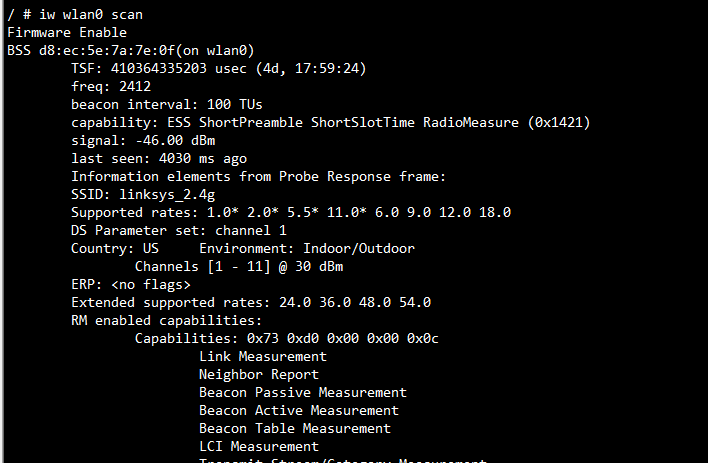
Scan with wpa_cli
Bellow commands is uesd to scan and get scan result on wlan0.
wpa_cli -i wlan0 scan
wpa_cli -i wlan0 scan_result
The following figure shows the result of above commands. It prints the detail result of scanned APs.
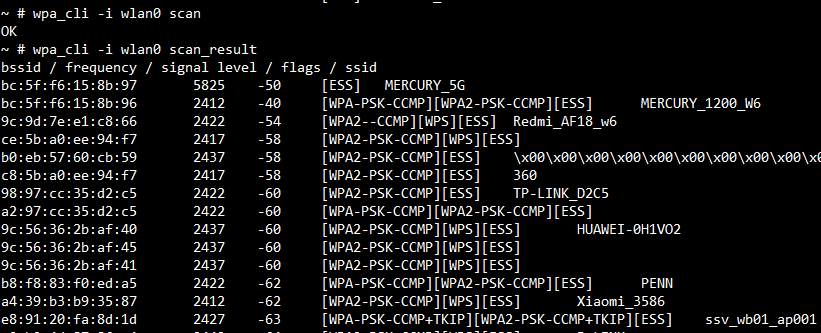
Set ssid and password
Bellow commands is uesd to set SSID and password on wlan0.
wpa_cli -i wlan0
add_network
set_network <network_id> ssid "ssid"
set_network <network_id> psk "password"
If AP is hidden AP, below command is necessary:
set_network <network_id> scan_ssid 1
Or, add scan_ssid=1 in the wpa_supplicant.conf for that hidden AP.
The following figure shows to set the SSID MERCURY_1200_W6 and password 12345678 successfully.
Note
wpa_cli -i wlan0 will enter the console of wpa_cli. All operation is running on wlan0. quit command can quit the console of wpa_cli.

Connect
Bellow commands is used to enable network and select network to connect.
enable_network <network_id>
select_network <network_id>
Note
If a network is stored in wpa_supplicant.conf, the wifi should connect the network automatically after run to wpa_supplicant.
Connect to WEP AP
wpa_supplicant
For WEP, below commands can be used to configure WEP SSID and connect the WEP AP.
# Open WEP key connection (two-message auth; no WPA, no IEEE 802.1X)
set_network id key_mgmt NONE
set_network id wep_key0 "abcde" // ASCII 64bit
set_network id wep_key1 1234567890 // hex 64bit
set_network id wep_key2 "1234567890123" // ASCII 128bit
set_network id wep_tx_keyidx 0 // key id
# Shared WEP key connection (four-message auth; no WPA, no IEEE 802.1X)
set_network id key_mgmt NONE
set_network id wep_key0 "abcde" // ASCII 64bit
set_network id wep_key1 1234567890 // hex 64bit
set_network id wep_key2 "1234567890123" // ASCII 128bit
set_network id wep_tx_keyidx 0 // key id
set_network id auth_alg SHARED
On other side, these commands can be replaced by below configuration in wpa_supplicant.conf.
# Open WEP key connection (two-message auth; no WPA, no IEEE 802.1X)
network={
ssid="static-wep-test"
key_mgmt=NONE
wep_key0="abcde" #ASCII 64bit
wep_key1=1234567890 # hex 64bit
wep_key2="1234567890123" #ASCII 128bit
wep_tx_keyidx=0 #key id
priority=5
}
# Shared WEP key connection (four-message auth; no WPA, no IEEE 802.1X)
network={
ssid="static-wep-test"
key_mgmt=NONE
wep_key0="abcde" #ASCII 64bit
wep_key1=1234567890 # hex 64bit
wep_key2="1234567890123" #ASCII 128bit
wep_tx_keyidx=0 #key id
priority=5
auth_alg=SHARED
}
iwconfig
For WEP, below commands can be used to connect the WEP AP.
iwconfig wlan0 key [id] hex //hex
iwconfig wlan0 key s:password [id] // ASCII
iwconfig wlan0 key [id] //choose psk id.
iwconfig wlan0 essid "ssid" //set ssid and connect
For more detail, please refer to iwconfig_8.
Connect with WPS
For WPS, below commands can be used when ap support and enable related capabilities.
Note
WPS doesn’t support WPA3 Wi-Fi security according to the specification.
WPS PBC
Excute below command and press the Push-Button in the router in 2 min, then network configuration can be received from the ap and stored in wpa_supplicant.conf.
wpa_cli -i wlan0 wps_pbc [BSSID]
Note
It may fail when there is more than 1 client or ap in PBC state.
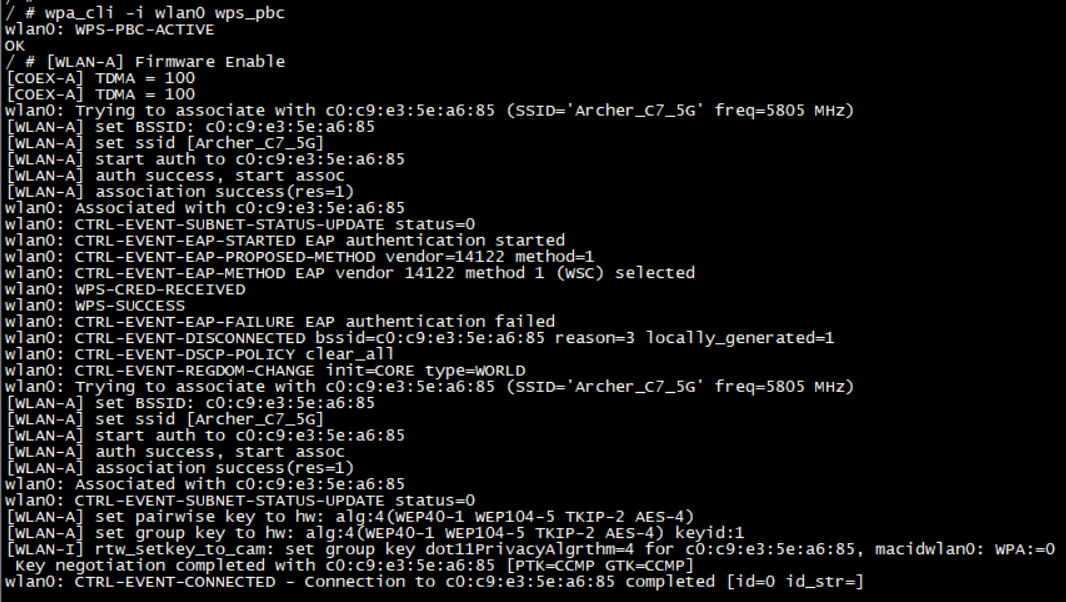
WPS PIN - Client pin
Excute below command, you will get a pin number or used specified pin value in this command. Input the pin number in the router and then network configuration can be received from the ap and stored in wpa_supplicant.conf.
wpa_cli -i wlan0 wps_pin <BSSID | any> [pin_number]
Note
The specified pin number used in the commands must be processed by an UI to remove non-digit characters and potentially, to verify the checksum digit. Below commands can be used to do such processing.
wpa_cli wps_check_pin <PIN>
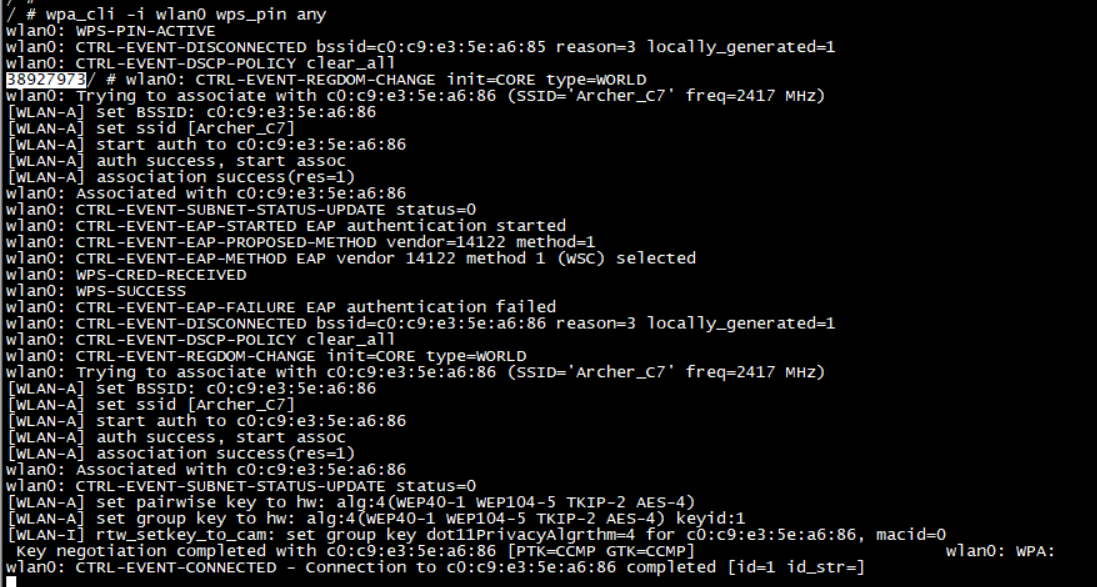

WPS PIN - Router pin
Enable router pin capability and get the bssid or the router pin value from the web_interface or the label in the router, use below command to connect ap.
wpa_cli -i wlan0 wps_reg <BSSID > <AP PIN>
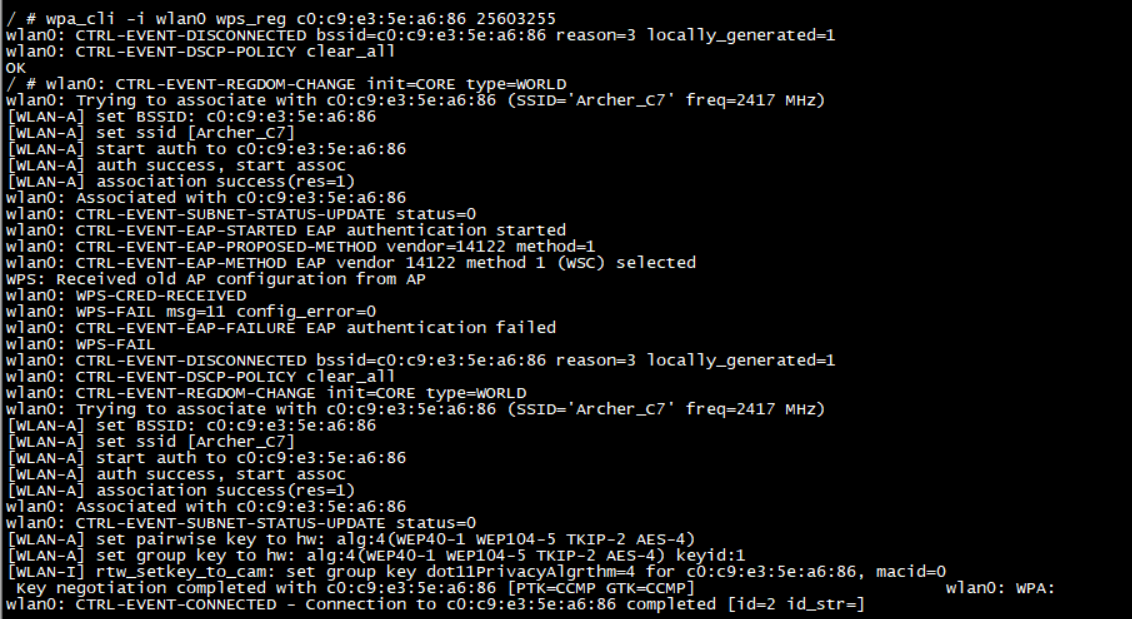
For more detail, please refer to WPS.
Disconnect and Reconnect
Bellow commands is used to disconnect network.
disconnect
Bellow commands is used to reconnect network.
reconnect
The following figure shows to disconnect network 1 then reconnect it is successfully.
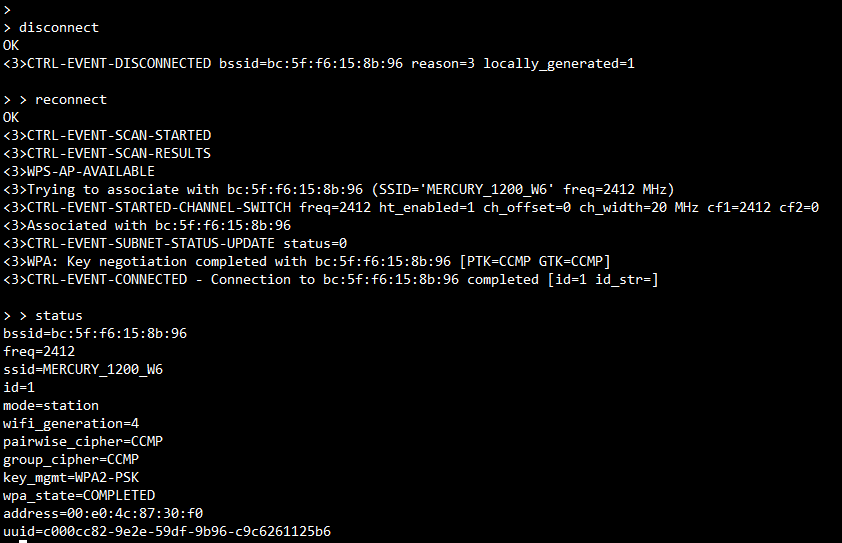
DHCP
dhcpcd wlan0 is used to get IP address from the AP’s DHCP server. The following figure shows the sample to run DHCP client and get the IP 192.168.1.101.
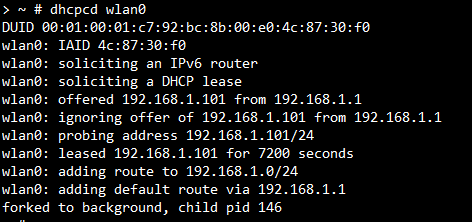
SoftAP mode
hostapd
hostapd (host access point daemon) is a user space daemon software enabling a network interface card to act as an access point and authentication server.
hostapd.conf
The hostapd.conf is the configuration file of hostapd and stored in /etc normally. It includes the parameters of SoftAP.
driver=nl80211
logger_syslog=-1
logger_syslog_level=2
logger_stdout=-1
logger_stdout_level=2
ctrl_interface=/var/run/hostapd
hw_mode=g
channel=1
ssid=sqb_test
beacon_int=100
dtim_period=1
max_num_sta=20
rts_threshold=2347
fragm_threshold=2346
ieee80211n=1
erp_send_reauth_start=1
wpa=2
wpa_key_mgmt=WPA-PSK
wpa_pairwise=CCMP
wpa_passphrase=12345678
Above file is an example for hostapd.conf, and it sets the SSID sqb_test and password 12345678. For more detail, please refer to hostapd wiki.
Run hostapd
Below command can run hostapd in background and start softap on wlan1.
hostapd /etc/hostapd.conf -B -i wlan1
The following figure shows to start softap successuffly.

Note
Whether wlan0 nor wlan1 can be running as softap. If one port works as softap and other works as station, the wifi is working in concurrent mode.
DHCP server
This flow is as below.
ifconfig wlan1 192.168.43.1
udhcpd -S /etc/udhcpd.conf
Test
Environment
Station Test Environment
Note
AP: a router with WiFi AP to support 11 a/b/g/n.
PC: a personal computer to connect to AP’s LAN port with Ethernet cable.
DUT: The device to test, it should be ameba smart board. It will connect to AP with wireless and connect to PC with serial port cable.
The PC can control the DUT with console of serial port cable.
Softap Test Environment
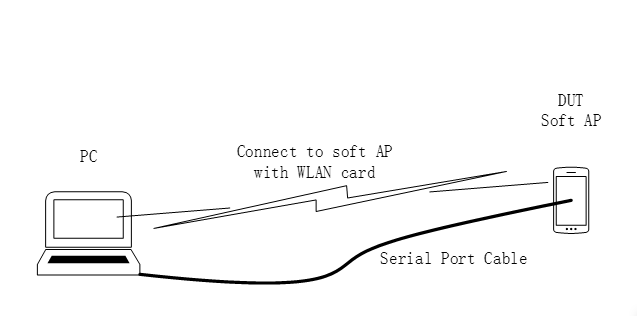
Note
PC: a personal computer with WiFi card to support 11 a/b/g/n.
DUT: The device to test, it should be ameba smart board. It will connect to PC with wireless and serial port cable.
The PC can control the DUT with console of serial port cable
Ping Test
ping in system is classic ping tool in Linux, and ping -h can get the help information. The following figure shows to ping the 192.168.39.2 and no packet loss.
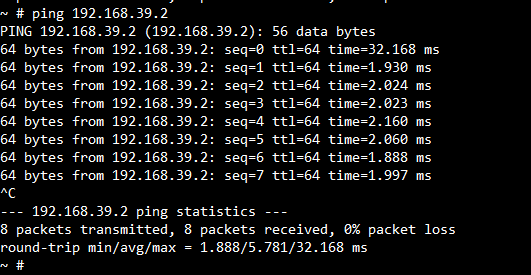
Throughput Test
This system support iperf3 to test the throughput of Wi-Fi, and iperf3 is classic in Linux. iperf3 -h can get the help information.
# To run as a server, UPD or TCP:
iperf3 -s -i 1
# To run as a client of TCP:
iperf3 -c ip_of_server -i 1 -t count
# To run as a client of UDP:
iperf3 -c ip_of_server -i 1 -t count -u -b bandwidth
Note
ip_of_server is the IP address of server.
The unit of count is second.
Bandwidth’s unit should be K, M or G. There are some errors in official windows iperf3 bin, so bandwidth should be set to the limit of real bandwidth of WiFi.
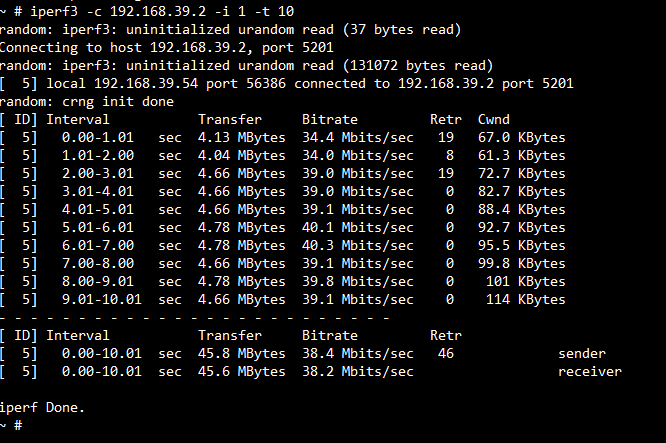
TP for TCP TX
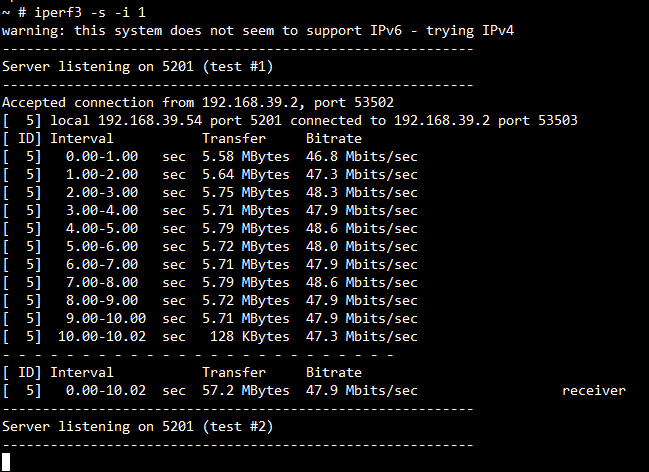
TP for TCP RX
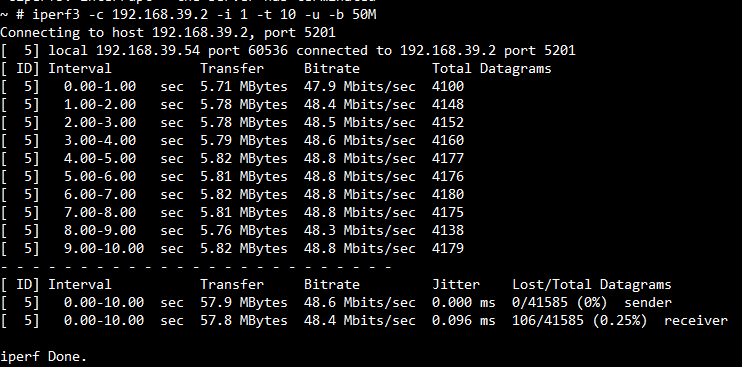
TP for UDP TX
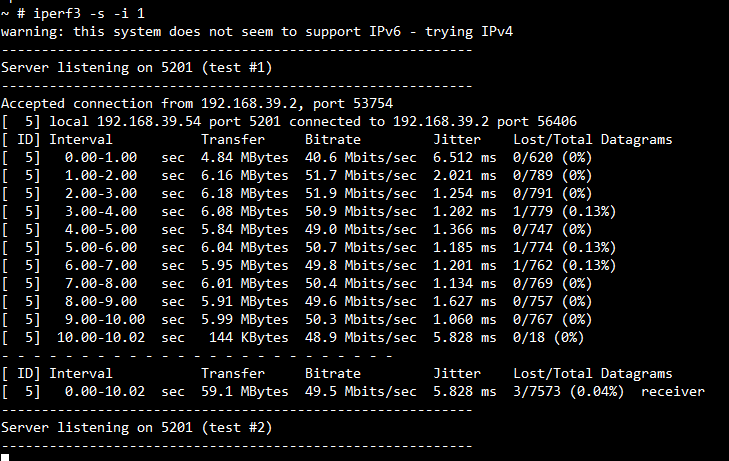
TP for UDP RX
DNS Test
Below command can add the AP_IP as the DNS server for Linux.
echo "nameserver AP_IP" >> /etc/resolv.conf
The following figure shows the result to ping www.baidu.com.
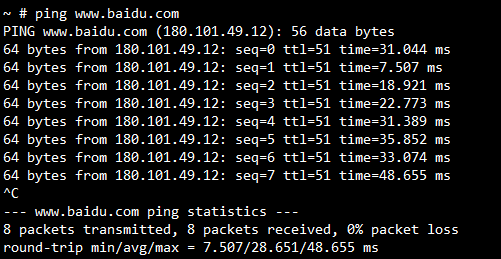
IP Forward
Below command can set the forward. The DUT connected softap can ping the AP connected by wlan0.
echo 1 > /proc/sys/net/ipv4/ip_forward
iptables -t nat -A POSTROUTING -o wlan0 -j MASQUERADE
Adb shell
If the adb function want to be used, the usb.sh adb should be executed on the board to initialize the USB adb function. Then to enter adb shell on the PC to connect to board.
The following figure shows to enter adb shell connecting board seccussfully.

Debug
Refer to the section of Trace Tool.